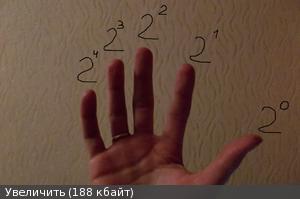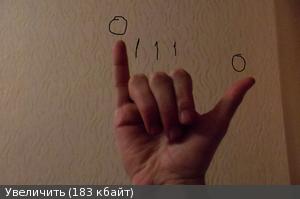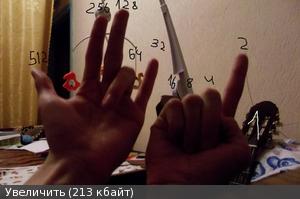We translate the numbers between the binary and decimal systems "on the fly", the explanation is "on the fingers"
Hello, Habrovtsy.
The post could be called: “For those who like to count on fingers”, but we will find out later.
Introduction : And what is the same pull. All that comes next, will go on the topic of counting in the binary system on the fingers. Who else does not know, I will try to explain what it is, how and why to master it.
I’ll start with the advantages:
1. It is convenient to transfer any number from decimal to binary system and vice versa, without using a calculator.
2. Finger motility develops.
3. Develops the visual perception of binary numbers.
Minuses:
1. A little workout.
2. It is impossible to show the numbers 26,27,352,378 and 891 in public places.
The bottom line :
Many probably had to translate between systems. And I think many people remember that:
2-10
3-11
4-100
5-101
etc.
It is logical that based on the fact that each digit has two states, we can depict this thing on the fingers.
Put your hand in front of you (palm to yourself), bend your thumb. That is the unit. Bend large and bend your forefinger, that's two. Ie an unbent finger is 0, and a bent one is 1. Since the leading zeros have been dropped, we have a countdown from the “leftmost” unit.
The names of the fingers are those that are curved:
medium, large - 101 - 5
nameless, average -1100 - 12
little finger, medium - 10100 - 20
To bend the little finger, you need some practice. But the essence is different. Imagine the width of each finger as 2 ^ n (in the photo)

I.e,

Now, imagine that we need to convert the number 25 to binary. Fold the little finger - 16, Unnamed - 8 and large - 1. because 16 + 8 + 1 = 25.

If they did not understand, then another example, the number 14, we think: The little finger is a lot, the average is normal, but you can take more, so we fold the nameless, it is 8. We remember, then the middle one is +4, this is already 12 and the index one is + 2, a total of 14.

Do the same with binary. Here, for example, we see somewhere: 1011101. We represent this on hands with digital capacity (already two hands).

64 + 16 + 8 + 4 + 1 = 93
We have: 1011101 (2) = 93 (10)
Conclusion : Thus, we can use this method from 0 to 1023, using fingers and possessing elementary arithmetic. But if you add at least one digit, you can count to 2047, and further to 4095, 8191, etc. And it can be hands, legs, eyelids, or something else that can have two states 1 and 0.
The post could be called: “For those who like to count on fingers”, but we will find out later.
Introduction : And what is the same pull. All that comes next, will go on the topic of counting in the binary system on the fingers. Who else does not know, I will try to explain what it is, how and why to master it.
I’ll start with the advantages:
1. It is convenient to transfer any number from decimal to binary system and vice versa, without using a calculator.
2. Finger motility develops.
3. Develops the visual perception of binary numbers.
Minuses:
1. A little workout.
2. It is impossible to show the numbers 26,27,352,378 and 891 in public places.
The bottom line :
Many probably had to translate between systems. And I think many people remember that:
2-10
3-11
4-100
5-101
etc.
It is logical that based on the fact that each digit has two states, we can depict this thing on the fingers.
Put your hand in front of you (palm to yourself), bend your thumb. That is the unit. Bend large and bend your forefinger, that's two. Ie an unbent finger is 0, and a bent one is 1. Since the leading zeros have been dropped, we have a countdown from the “leftmost” unit.
The names of the fingers are those that are curved:
medium, large - 101 - 5
nameless, average -1100 - 12
little finger, medium - 10100 - 20
To bend the little finger, you need some practice. But the essence is different. Imagine the width of each finger as 2 ^ n (in the photo)

I.e,

Now, imagine that we need to convert the number 25 to binary. Fold the little finger - 16, Unnamed - 8 and large - 1. because 16 + 8 + 1 = 25.

If they did not understand, then another example, the number 14, we think: The little finger is a lot, the average is normal, but you can take more, so we fold the nameless, it is 8. We remember, then the middle one is +4, this is already 12 and the index one is + 2, a total of 14.

Do the same with binary. Here, for example, we see somewhere: 1011101. We represent this on hands with digital capacity (already two hands).

64 + 16 + 8 + 4 + 1 = 93
We have: 1011101 (2) = 93 (10)
Conclusion : Thus, we can use this method from 0 to 1023, using fingers and possessing elementary arithmetic. But if you add at least one digit, you can count to 2047, and further to 4095, 8191, etc. And it can be hands, legs, eyelids, or something else that can have two states 1 and 0.
')
Source: https://habr.com/ru/post/140102/
All Articles